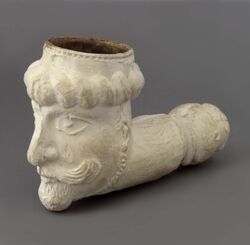Turk head from Gouda
November 2020

Around the year 1700, the Gouda mould maker Crijn Dircksz. Veverloo designed a pipe bowl in the shape of a Turks head. For that time it was a remarkable creation: a somewhat primitive head with a large nose, poorly profiled eyes and ears, a simple goatee and a turban marked with oblique rolls. You feel how the craftsman searched for an image without having any experience. The simple turban is just enough to suggest that it is an Oriental, but certainly not an artistic depiction. At that time, however, the invention was special, because hardly any figural pipes were made in Gouda. Eventually, his creation turned out to be a good one, the pipe quickly became popular. Although we do not know anything about the possible clients or the sales area, this design has been made and copied in countless variations. Usually as a stemmed pipe like most clay pipes in Gouda. In addition, there is also a version with a cuff, a truncated stem like this one. To complete, a reed stem is inserted into the stem end. That way of mounting the pipe indicates inspiration from Central Europe. What is unexpected about this tobacco pipe is that it doesn’t bear the usual brand stamp with the tree of Veverloo, but the pipe maker brand lily. At the time, the lily was owned by Neeltje Lamberts Verwint, widow of Joost Pieterse de Meijer, an important pipe merchant. As a surface find, it is highly exceptional that this pipe has emerged undamaged.
Amsterdam Pipe Museum APM 24.086
Permalink